
Farewell...
Workspring has chosen not to renew its lease in downtown Chicago. It has been our team’s pleasure to provide thousands of training, brainstorming and strategizing experiences to companies across the globe, and we are grateful to all of our customers. If you need to contact us, email info@workspring.com.
Chicago Ideas Week Recap: “Step away from the projector”

and 8 other ingenious ways to present content
by Stephanie Lyons, Business Development Specialist at Workspring
Kim Erwin described herself as a “recovering design consultant” and started off quickly discussing her role as a professor at IIT, she designs for solutions.
She started off the Chicago Idea’s Week lab session asking participants to use post-its to write and discuss a single communication problem that their company is having. Some communication problems that were discussed with the audience; communicating bad news up, lack communication between management teams, poor communication of feedback, criticism and ways of change.
Kim approaches and categorizes most communication problems into two different categories: the Understanding Gap- fuzzy, unfamiliar and complex information that is hard to communicate to outside members- the question becoming how to communicate this information better. The other category is the Conviction Gap- which is when there is no faith in the person giving the information or telling the story, or information and ideas suggesting things that tear apart the social structure.
This discussion of two different information gaps was discussed and Kim pointed out that Power Points, slide decks and etc. are a major problem in our culture, remarking that 3rd graders are being taught how to PowerPoint present and how it is detrimental to new ideas and creation of understanding.
She mentioned this as she begged for the audiences forgiveness for going through her own power point slides.
There are 8 moments where you must step away from the projector and break convention in presentation to best get the message through:
- You don’t know your stakeholders or they don’t know each other SOLUTION Create a Conversation Space Kim gave the example of showing the SC case teams using tall round table information on papers, objects or other stimuli addressing what needs to discussed and for information deconstruction
- You need to build a shared mind SOLUTION Plan an immersive exchange Example of different NGO’s from Africa and India needing to discuss best implementations of their programming and to save the disconnect there were 5 oversized images projected of subsistence farmers in India and Africa throughout the space
- You need to build trust SOLUTION Engage in a shared problem Chicago community health workers were involved in a co-design session – involving those who will actually be using tools being designed, the stakeholder team was able to understand that educational pieces of paper or handouts would not work for patients, instead they designed presentation flip charts that the workers could use while visiting homes, etc. so they could stand and present information contained all in one space.
- Your idea is complex or subtle- SOLUTION Put concept in the hands of decision makers
- Your idea isn’t done- SOLUTION Dramatize the process
- Your idea needs context SOLUTION create direct experience
- Your story needs to add to itlsef SOLUTION create a 360 degree breakthrough
- Your story needs to travel SOLUTION give tools or deomonstration objects to help others tell the story
These moments all work around the goals of immersion, exploration, engagement, interaction and extension in information gathering and sharing
After the presentation from Kim she addressed the group and gave out 2 pieces of physical collateral – one addressing all of the 8 moments and another with 4 principles to help design your own step away experience.
4 Principles to help you design your own information presentation experience:
1) Move the story from the deck to the room
Space is an active actor in innovation. Our brains are wired to respond to spatial cues and settings. Presentations by contrast only engage the six inches between our ears, and so offer a relatively narrow channel for learning and engagement
2) Get people out of chairs in to action.
Watch the energy level go up when the chairs go out. The physiology of attention says that every time we stand, our brains work harder to take in what’s around us and organize a plan of action so that we are ready for what might come next. All that increased attention enhances our information processing
3) Force tight proximity between data and people.
Open space is not your friend when creating an experience. Something happens when people stand shoulder to shoulder- they judge less, investigate more. And they attend to what’s interesting to them, dwelling on points at their own speed. Research shows, too, thatwehn we attend to something close in our field of vision, distractions fade away and we Focus
4) Create an exchange with people and new information.
Traditional presentations presume knowledge can be transferred accurately and completely from the speaker to people in the room, a model of communication that has been widely discredited. To help others internalize information, engage the body, promote conversation and externalize the group’s thinking by inspiring teams.
Her ending remarks focused on asking the question of who was attending this potential meeting; Leaders or Funders, Implementors or Core Team members and Accelerators. Accelerators are the champions of the ideas or process and must be utilized for giving forward motion to the solution.
These highlighted ways of meaningful and different objectives help create Awareness (prepare the organization), Contribution (leverage the experience), and Alignment (building conviction).
Discover more insights in our Insights Library or call us today to discuss how you can bring progress to your team – 800 605 9092.